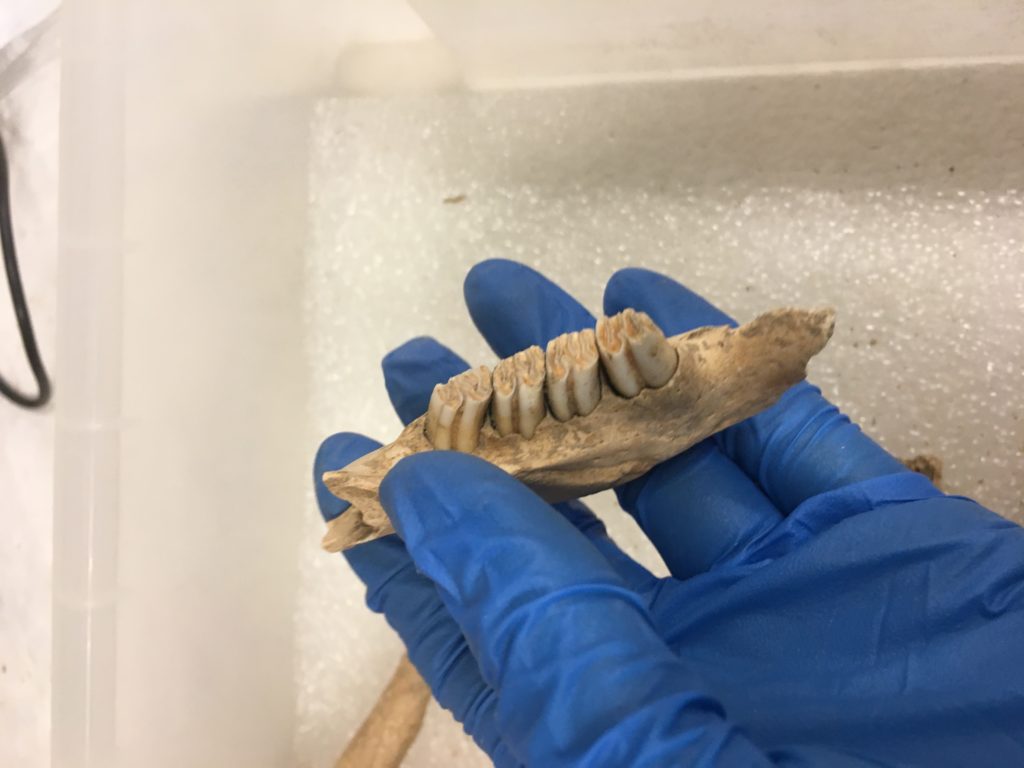by Maclaren Guthrie

Hi everyone, it’s Maclaren Guthrie back with another blog post! This time I’m excited I get the opportunity to talk about something that’s really of interest to me lately – identifying animal teeth.
Though this rehousing angel mounds project is all about the physical rehousing and conservation of the angel collection, we do see a lot of really interesting artifacts in our daily routines. This first segment of the project is focused on the packing crates of moldy bones due to our method of need-oriented rehousing. While our main task is to locate mold and deal with it and the task of putting these artifacts into new bags and boxes, a lot of us can’t help but try and figure out what type of animal’s bones we may be looking at.
For me, I’ve been particularly interested in the identification of animals by their teeth. We find quite a few teeth on a day to day basis, which is really cool and helps to show what species were hunted, eaten, or present in the lives of the Mississippian people at Angel Mounds. Teeth are a great way to identify this information because teeth are less likely to decay because of their density.

Prior to this project, I was not the most experienced in identifying animal teeth with the exception of cows and pigs due to their common presence on historic archaeological sites. Lucky for this project we have Amanda Burtt, a zooarchaeologist, on staff to help us with our identification questions – which we have lots of.
So far, the most common animals we have been rediscovering in the collections are raccoons, deer, and fish which is unsurprising for the most part. We have definitely found some other cool species in the collections through identifying teeth, such as bear, river otter, opossum, dog, beaver, bobcat, and various rodentia. We’ve also found multiple bird beaks.

Identifying animals, specifically by just looking at teeth or possibly a mandible, can include a few different strategies which can really depend on experience in working with faunal remains. For me personally, as I don’t have much experience in this area as of now, I go through a little flowchart in my head to help me narrow down what animal the teeth could belong to. First, the size – this is a helpful observation that should start me off in the right direction whether I am looking at just a tooth or a mandible with or without the teeth still attached. Next, I look at the shape of the tooth. If it has a mostly flat crown I know it could be a molar, if it’s long and pointed it could be a canine, etc. Knowing what kind of tooth you’re looking at is important because the shape of that specific tooth gives you an idea of what type of animal that would have a tooth that looks like that – i.e. a wolf would have larger canine teeth than a raccoon, or a carnivorous animal like a dog would not have flat-topped molars like herbivores like deer or omnivores like humans. Having multiple teeth together, perhaps still in a mandible, is even easier since you can tell whether or not the individual was homodont (one type of teeth) or heterodont (multiple types of teeth) which would also allow us to tell what the animal could have eaten and therefore give us hints to what species the animal may have been. Fortunately for us, Amanda Burtt also brought a handy comparative collection that can help with this process for teeth and other animal bone identification.

Teeth are also helpful in ageing an animal. For example, we can tell whether or not an individual is a juvenile or adult based on if the teeth are deciduous “milk” teeth or permanent dentition since most mammals are diphyodont and have two sets of teeth throughout their life. Another way teeth can be aged is due to wear – it seems only logical that the more worn a tooth is the older the individual would have had to been to have used it enough to wear it down. There can be other factors that effect this, though, as different diets wear teeth differently. An example of this in the Angel Mounds rehousing project is various raccoon molars, usually still attached to the mandible, have been noted to have very worn down molars. This could mean they were older or they could have been eating a harsher diet that was harder on their teeth.

A lot of information can be gained by studying animal teeth that can then help us better understand the people of Angel Mounds and beyond. Knowing the species, and sometimes age and diet of said animals, gives us more of an insight into the daily lives of the animals and the people they most likely came into contact with. Teeth are a great resource to use since they are often found in the archaeological record.

